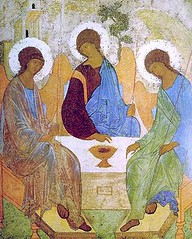one of the classes i'm taking this semester is called christian imagination. i don't know exactly how to describe the class this is what it says on the syllabus:
"Our intention in this class is to deepen our understanding of the relationship between the Christian Gospel and the human imagination: that is, all of those ways of expression and communication which depend primarily on images. Imagesâ do not refer only to the visual, but to any meaning-full appeal to the senses. So another name for the course might be "Christian aesthetics": we are concerned not only with "the arts", but with the life of the senses generally, and how it relates to our life in Christ. (The opposite of "aesthetic" is not "rational" or "logical": it is rather "an-aesthetic"). Any Christian who lives in and through a body is encouraged to take the course."
anyway, we're focusing on art, on creating, and what that has to do with our faith, with God, with his incarnation. Christian aesthetics. it's been pretty cool so far. i'm thinking it will encourage my creativity and writing.
last night we learned a bit about icons. the danger in creating an image of God, is that you are potentially creating an idol, because God can't really be captured on paper, in paint, in scuplture. in Islam, there is a great fear of this, so there is no imagery involved in that religion.
with that in mind, we are creatures that think in the form of images, even words, which are formed in visual ways (tractor ---> tract --> "pull apart" can't you just see the earth beeing pulled apart with that word?) images are important. (this is a horrendous abbreviation of a 3 hour lecture by the way, so i'm probably leaving good stuff out)
so we looked at icons, "windows on eternity" he called them. not meant to be exact representations, because who could do that anyway? but to remind us that there are things greater than ourselves.
this picture i posted is by rublev, "the Holy Trinity". the interesting thing about it, is the composition of the picture, the lines, the vanishing point (art terms i don't really know how to explain) are in the front of the picture, at the bottom. not at the top or behind the father son and holy spirit. the effect here draws you into the painting. the viewer is drawn in to the scene and you join the trinity at the table. the miracle of being in relationship with God. simply beautiful.

No comments:
Post a Comment